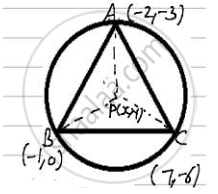Advertisements
Advertisements
Question
Find the circumcenter of the triangle whose vertices are (-2, -3), (-1, 0), (7, -6).
Solution
The circumference of a triangle is equidistance from the vertices of a triangle.
Let A(-2, -3), B(-1, 0) and C(7, -6) vertices of the given triangle and let P(x,y) be the circumference of this triangle, Then
PA = PB = PC
Now, PA = PB

`=> sqrt((-2-x)^2 + (-3 -y)^2) = sqrt((-1 - x)^2 + (0 - y)^2`
`=> 4 + x^2 + 4x + 9 + y^2 + 6y = 1 + x^2 + 2xz + y^2`
`=> 4 + x^2 + 4x + 9 + y^2 + 6y - 1 - x^2 - 2x - y^2 = 0`
`=> 2x + 6y + 12 = 0
=> 2(x + 3y + 6) = 0
=> x + 3y + 6 = 0 ... eq (1)
And PB = PC
`=> sqrt((-1-x)^2 + (0 - y)^2) = sqrt((7- x)^2 + (-6 - y)^2)`
Squaring both the sides
`=> (-1 - x)^2 + y^2 = (7 - x)^2 + (-6 -y)^2`
`=> 1 + x^2 + 2x + y^2 = (7 - x)^2 + (-6 - y)^2`
`=> 1 + x^2 + 2x + y^2 - 49 - x^2 + 14x - 36 - y^2 - 12y`
=> 16x - 12y - 84 = 0
`=> 4(4x - 3y - 21) = 0`
=> 4x - 3y - 21 = 0 ......eq(2)
Adding eq(1) and eq(2)
`=> x + 3y + 6 + 4x - 3y - 21 = 0`
=> x + 3y + 6 + 4x -3y - 21 = 0
=> 5x - 15 = 0
=> x = 15/5`
=> x = 3
putting the value of x in eq (2) and
we get
`=> 4 x 3 - 3y - 21 = 0`
`=> 12 - 3y - 21 = 0`
`=> -3y - 9 = 0`
`=> y = (-9)/3 = -3`
So the coordinates of the circumcentre P are (3, -3)
APPEARS IN
RELATED QUESTIONS
If the point (x, y) is equidistant from the points (a + b, b – a) and (a – b, a + b), prove that bx = ay
Name the type of quadrilateral formed, if any, by the following point, and give reasons for your answer:
(−3, 5), (3, 1), (0, 3), (−1, −4)
Two opposite vertices of a square are (-1, 2) and (3, 2). Find the coordinates of other two
vertices.
If A (-1, 3), B (1, -1) and C (5, 1) are the vertices of a triangle ABC, find the length of the median through A.
Find the distance between the points
(ii) A(7,-4)and B(-5,1)
Determine whether the points are collinear.
L(–2, 3), M(1, –3), N(5, 4)
Find the distance of the following point from the origin :
(8 , 15)
The distance between the points (3, 1) and (0, x) is 5. Find x.
The length of line PQ is 10 units and the co-ordinates of P are (2, -3); calculate the co-ordinates of point Q, if its abscissa is 10.
Find the points on the x-axis which are at a distance of `2sqrt(5)` from the point (7, – 4). How many such points are there?
